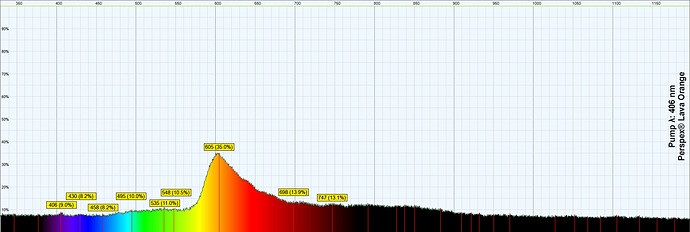Hmmm… now you have me wanting to try some of the same. I do have some plastic material from a yellow wavelength medical hand held wand which is pumped with 532 nm.
Sounds like a solid state dye. I’ve seen those adaptors for pulsed 532’s before.
Bought it from Starlight Photonics on ebay.
Just tried to quickly find it.
If you have a link to one, can you share it please?
I’ve got to pop out for a bit. I’ll share more data later. Still got to make sense of it all.
The purchase was in 2020 or earlier, all I can find on it now is this:
Polymer Laser Dye Cell Convert Q-Switched 532nm to 585nm Yellow ConBio Continuum Dye Lasers for sale | eBay
Seems even when looking at my past ebay purchases, they don’t keep the data on that purchase from so long ago, but it does show I purchased an item of that description.
First lot of relative intensity graphs added to the fluorescent yellow sample. I have equalised the heights of the background noise for a fair test to be relative to other spectrums. That way you can see how intense the emission actually is at each wavelength relative to the input intensity. These take a while to do as I have to manually scale each one based on a reference spectrum, and then delete everything not needed and overlay them back onto a graph.
Edit: All updated.
Best power input ratio to power output of the fluorescent peaks appears to be the 406 and 532 nm pump wavelengths?
Appears so depending on the sample. However I’ll go one by one and analyse them for you.
Haven’t forgotten to update the spectro’s. This next stage is entirely manual and long winded.
Also had a set back over the weekend. Had to put my dog down.
Is this easier to understand, before I put my time to editing all of them?
From this I should be able to make a table too.
I have already updated two spectrums for the lava orange sample.
Is that the fluorescent response?
Edit, never mind, has to be. Looks good.
Mostly fluorescence. However the output is larger than the input on a lot of the spectrums. Like many dye lasers, these are tuneable so won’t have a narrow linewidth. These samples are promising. Just will need a well designed cavity and a low transmitting output coupler. I’m looking out for those repeating lines. And also checking the pump intensity vs the fluorescence intensity.
I like yellow narrow or not 
Once lasing the linewidth should self-narrow anyway. Most solid states behave like a fluorescent material before reaching lasing threshold. The question is, how easy and how low is the energy required to get these samples to actually lase?
Wondering if you will need to q-switch pulse to get enough power or lasing.
Based on the research paper, it appears that cw can in fact work. I would like to avoid pulsing if I can.
For years they thought cw operation in ruby was impossible. But it is found you just need the right cavity for it to work. It is probably why you need such a high reflectance rating on the coupler. Also I need at least one concave mirror to create a focus within the lasing cavity. I can use an ordinary lens for the pump beam.
well, that’s good news, I want to see that work! Then I can try my Starlight Photonics fluorescent yellow rods without needing a YAG to 532 nm Q-switched output.
I would like to know what material they use in those starlight adaptors.
I burned one trying to get it to make yellow using my 10 watt DPSS 
Melted it a bit on one end, but it can be cut off and re-polished. I will send it to you, if you want.
Catch you later, driving home soon.
Oh, can’t have a high damage threshold then.
Later Chris. I’ll probably post more here for you to look at when you can.
